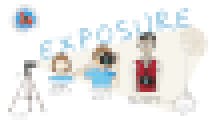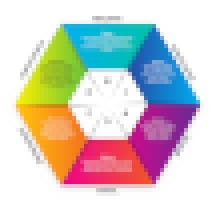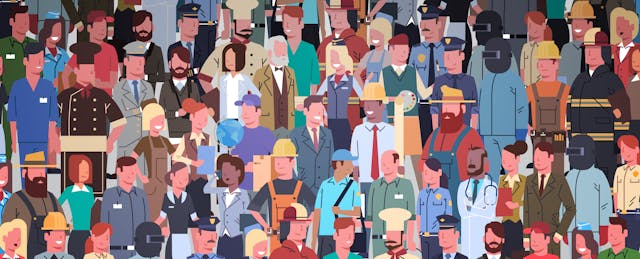A few years ago, after 15 years in the classroom, something clicked for Melanie Brandt’s students. They started recognizing their own strengths and—even better from her perspective—the unique talents of their classmates. She was teaching fourth grade when a new integrated curriculum focused on careers was introduced district-wide—and it was making her lessons more relevant to the real world.
Suddenly, lessons on the physics of energy were tied to teaching kids how to be theme park engineers, and language arts and math lessons were anchored in running and marketing a profitable startup. She noticed her students were more engaged, and there were other benefits too. Their natural interests and abilities became apparent—whether it was writing, drawing or a head for numbers. They worked better independently, solving issues on their own and crucially, they began to collaborate more, relying on one another for things they were already good at. The end result was a class that was less stratified by academic ability.
“I saw a huge shift in my classroom where everybody’s unique skills now had a place and that just transferred over for the rest of the year,” Brandt says. “And in other subject areas, and on the playground. The students just rose to the occasion of learning about themselves.”
Brandt’s experience took place during the pilot year of a custom-built curriculum called World of Work, which leverages research on vocational psychology, namely the idea that students’ interests should influence their career aspirations. Under this premise, students as young as kindergarten can begin to find their place in a world they will one day inherit.
Each year, from K-8, the program exposes students to a range of careers, providing opportunities to explore through hands-on learning, meeting people who work in the field and eventually practicing skills related to each profession. It may sound like another project-based curriculum, and in some ways it is. But it also puts value on deep personal introspection, encouraging kids to consider how school can support their future selves.

Building Identity
East of San Diego, the city of El Cajon is the poorest in the county. A third of its residents are foreign born. It’s here that Brandt teaches, at the Cajon Valley Union School District, which serves about 16,000 students through eighth grade. For Brandt, part of the attraction of the World of Work program was not only to prepare students, but also to get them personally invested in careers they may not have known existed. And maybe even escape the confines of generational poverty.
But Brandt says the program is aimed at all students, regardless of circumstance. “It’s not only for the lower income students, it’s really for everybody,” Brandt says. “So that they pursue their postsecondary education goals based on their interests and what’s going to ultimately make them happy and gainfully employed.”
It’s not a completely canned curriculum either. There are guidelines, of course, but no scripts, and teachers have wide latitude in determining how to weave career education into their classes. That’s by design. Ed Hidalgo, the district’s chief innovation officer, who wrote the curriculum, explains that the goal is to spark formative conversations but they can happen in a variety of contexts.
“We have this standardized process for students,” says Hidalgo. “You matriculate through all these years of schooling, but no one ever really stops to have a conversation with you about, really, who are you?”
Four years ago, while working for computer chip maker Qualcomm, Hidalgo developed a makerspace for middle schoolers and led guided tours for kids who didn’t know what semiconductors were. The engineers who participated liked working with kids, and many shared their frustrations with never receiving much targeted help with career development in school. Slowly, Hidalgo began putting the pieces together.
In high school, he reasoned, students might take vocational training courses, intern at local businesses or meet with guidance counselors to discuss their future. But it rarely starts any younger. Specifically, he wondered why the field of vocational psychology wasn't being translated to elementary and middle school, when the students he worked with at Qualcomm seemed invested and eager to learn.
Hidalgo began to envision a program where students would learn about their interests and natural abilities and tie them to specific careers covered in their core curriculum. The process would help them figure out what they did—and didn’t—want to do when they left school. So, in 2016, he left Qualcomm and developed the program at UC San Diego before bringing it to Cajon Valley at the behest of its superintendent.
Starting with 5-year-olds was an odd, but highly intentional choice. “We know that children as early as 7 years of age start to foreclose on opportunities and they especially do it based on gender stereotypes,” Hidalgo says. In early grades, parents are often more hopeful about their children’s futures. They're also easier to reach because they must drop off and pick up their children from campus despite hectic schedules.
“We have to help them actually build a vision,” Hidalgo says of parents, adding that it’s already baked into the fabric of some families, particularly wealthier ones. For others, he says, “We have to bring that into the school, into the family’s life, so they can see that their child can absolutely compete.”
It also helps that kids are most excited about school when they’re young. While enthusiasm can fade with age, at Qualcomm he noticed middle school students would still snap to attention when it came to the jobs they could one day have, the money they could make and their own interests.
Testing the Theory
Cajon Valley’s application of vocational psychology is unique for a school district that doesn’t serve high schoolers. Especially considering it’s grounded in research that’s mainly familiar to older students, who at some point in their teenage years may be asked to take a career assessment.
These tests are based on the work of John Holland, a psychologist whose theory on vocational choice in the mid 20th century is foundational for the field. According to Holland, different work environments are preferable to our unique personality traits. And those traits dictate how much we’d enjoy and excel at working in such environments. An individual with a detail-oriented personality, which Holland called Conventional, would probably feel uneasy in a bustling showroom glad-handing customers all day or brainstorming ideas at an ad agency—but might enjoy a career in banking or data processing instead. Holland developed a hexagonal model called the RIASEC to represent the relationship between personality and career environments—organizing the model into six “interest codes.”

To help people make easy connections between their interests and ideal work environments, vocational researchers developed assessments based on the RIASEC model. Each test consists of a series of generic questions about work habits and interests—I like to cook; I like to do puzzles; I’m good at working independently—and matches affirmative statements with interest codes that attempt to shine light on both personality and ideal work environments. The RIASEC name itself is an acronym of the initial letters of each of Holland’s interest codes: Realistic (also known as Doers), Investigative (Thinkers), Artistic (Creators), Social (Helpers), Enterprising (Persuaders), and Conventional (Organizers).
At the end, test-takers are given three such interest codes—the first of which, known as the “leading” code, is the most important. From there, they can discover careers that line up with their codes.
“Anecdotally, there's a high degree of alignment between what people once said they wanted to do when they were younger and what they're doing today,” says Tim Poynton, an associate professor of counseling and school psychology at the University of Massachusetts, Boston, who teaches aspiring school counselors and often has them reflect on their earliest career memories and whether it relates to their chosen profession.
At Cajon Valley, students don’t actually take RIASEC exams until middle school, in line with most recommendations. But starting in kindergarten, teachers are told to observe students and help make connections between their interests, personalities and various work environments. Each year, students are exposed to six different careers, one for each interest code, a mix of professional occupations requiring advanced degrees (doctor, theme park engineer) and jobs that students might enter into shortly after leaving high school (florist, mechanic).
“There’s options for every student and we want students to feel empowered that they can go and pursue those trades” says Brandt, who left the classroom in 2018 to help implement the program for the district. “We want students to say, ‘I’m a carpenter because I love doing this work. It fits within my interests and strengths. It’s a passion of mine. And I got into the trades because I love what I do.’”
Students start the program simply by learning about the codes. As students age, the curriculum scales in complexity, building on what students have already learned. In younger grades, they learn terminology and pass around related objects, such as firefighter jackets and helmets, while older students engage in projects tied to curricular objectives. Units on statistics, for example, are examined through the lens of data scientists and language arts classes focus on structuring point-by-point instructions like a technical writer until the students can see themselves working that job.
More importantly, the goal is to hammer the RIASEC career codes into students so they’re naturally making connections until it becomes almost reflexive. Hidalgo once visited an elementary class where students discussing “Charlotte’s Web” assigned interest codes to the different characters and relating themselves to each character’s actions. ”I went up to the teacher and said, ‘Can you explain what is happening,’” he recalls. “And the teacher says, ‘I didn’t ask the students to do it.’”
In addition to the curricular connections, each class uses a career platform called Nepris, which connects professionals with classrooms for video Q&As where students get to ask their own questions (including the perennial favorite: How much money do you make?).
Along the way, there’s a recognition that a student’s interests may change, and that’s OK, even valuable. It’s one of the reasons why students work through a different career in each of the six RIASEC codes every year, though it’s not the only reason. The curriculum also tries to undo some of the social “foreclosure” on careers, or the often ingrained idea that gender, race or economic status is an insurmountable barrier to working in a given field. Along the way, students are taught to build a profile of themselves, a sort of mission statement, to take with them to high school, which includes a portfolio of work but also their interests and strengths.
That tracks with how programs like World of Work should ideally be designed, says Poynton, the UMass professor who studies career counseling. “The focus, in my opinion, should be less about the specific occupations,” he says. “Where possible, in terms of helping young people understand themselves in their relation to the world of work, the goal should be to try to focus on the environments.”
A Lifelong Knowledge
Heather Bergin might be what those in the edtech world call an “early adopter.” Bergin currently teaches first grade but she’s taught elementary grades at El Cajon’s Anza Elementary for years, mainly grades K-2. Unusually, she had followed Hidalgo's development of the program at UC San Diego and dove in before anyone even asked her to.
“I found out that this was an interest of mine,” she explains. At a time when personalized learning has trickled into classrooms across the country, Bergin relished the opportunity to observe her students more thoughtfully and tailor assignments to things they already liked. She considered each of the six RIASEC codes and looked for ways to incorporate them into her activity centers, where students rotate through stations centered on a particular code. When she got to civil engineering, a career aligned to the Investigative code, she brought the whole class together to build a city out of cardboard boxes as part of a unit on 3D shapes.
“In kindergarten, first and second grade, a lot of students are more Realistic but it starts to change,” says Bergin, suggesting that young kids prefer hands-on projects. But as students move through elementary school their interests and abilities shift. They might become more gregarious or fine-tune their artistic ability, which in turn influences how they see themselves and their possible careers.
At first, Bergin spent a lot of time massaging the careers into her existing curriculum since there wasn’t much guidance. Teachers were given a crash course in the RIASEC framework, taking the test themselves, and learning some strategies for incorporating it into the classroom. For some of Bergin’s colleagues, it’s come with a learning curve. “That's where some teachers struggle because they want to follow clear steps,” she says. “But it gives me the freedom to be the teacher versus me being a person reading off a script.”
Teachers have other concerns too. At district meetings Bergin sometimes hears teachers grumble about the program. Why is it that there’s money for this but not to keep class sizes low, they ask. When do I have time for this?
There’s always negativity, she says. “But I think once people actually dive in and look into what the RIASEC is”—and the research behind it—they start to see how it helps them support students in finding their strengths and interests. And it typically makes up some of the most memorable parts of the school year for students.
“That's why I became a teacher,” she says. “Not to just go through the motions and go day to day. I want them to have that lifelong knowledge of themselves.”


